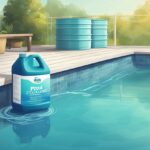Cloudy pool water is a common issue that you might encounter, and it can stem from various causes, including chemical imbalance and environmental factors. Understanding these causes is key to effectively addressing the murky appearance of your pool. It’s important to note that cloudy water is not just an aesthetic problem; it can also be indicative of an unhealthy swimming environment, potentially harbouring bacteria and other unwanted organisms.

To get started on clearing your pool, you’ll need to first examine the chemical balance of the water. Ensuring the correct levels of pH, chlorine, and alkalinity is essential, as imbalances can contribute to the cloudiness. Environmental factors like weather, high usage, and debris can also introduce contaminants into the water, which can affect the clarity of your pool.
Regular maintenance and proper filtration play crucial roles in preventing and resolving cloudiness. By vigilantly checking your pool’s chemical balance and ensuring your filtration system is functioning properly, you can keep your pool crystal clear. Remember, a cloudy pool is a fixable problem, and with the right approach, you should be able to enjoy pristine water in no time.
Understanding Pool Water Clarity
To ensure your pool remains a safe and inviting place, it’s crucial to keep the water clear and balanced. This involves regular maintenance and understanding the factors that can affect water clarity.
Identify the Causes of Cloudiness
Cloudiness in your pool water can stem from several sources, and identifying the exact cause is the first step towards remediation. Common culprits include:
- Environmental factors: Debris such as leaves, dirt, and pollen can accumulate in your pool, impacting water clarity.
- Chemical imbalances: Incorrect levels of chlorine, pH, alkalinity, and calcium hardness can create an environment where bacteria and algae thrive, leading to cloudiness.
- Bacteria and algae: These organisms can multiply quickly in warm water, especially if the chemical balance is off.
- Filtration issues: A clogged or malfunctioning filter system can fail to remove contaminants effectively.
Addressing each of these factors is essential for restoring the crystal-clear water you desire.
The Role of Water Testing
Consistent water testing allows you to understand the current condition of your pool water and take informed action. Here’s how:
- Chlorine levels: Strive to maintain free chlorine levels between 1-3 parts per million (ppm) to effectively sanitise the water.
- pH levels: Ensure the pH is within the ideal range of 7.2-7.8 for optimal disinfectant performance and swimmer comfort.
- Total alkalinity: Aim for an alkalinity level between 80-120 ppm to help stabilise pH levels.
- Calcium hardness: Calcium hardness should be kept between 200-400 ppm to prevent surface damage and water cloudiness.
Utilising pool water testing kits, you can measure these parameters and adjust your chemical management accordingly. Regular testing not only helps prevent cloudiness but also extends the life of your pool and ensures the health of its users.
Balancing Pool Chemistry
Proper balancing of your pool’s chemistry is essential for maintaining clear, hygienic water. Mismanaged pH or chlorine levels can lead to issues like cloudiness and make your pool an unwelcoming environment.
Adjusting pH and Alkalinity
To maintain a comfortable swimming environment and effective disinfection, ensure your pool’s pH level is between 7.2-7.8. A pH level outside this range can cause irritation to swimmers and reduce the efficacy of chlorine. If your pH is too high, use a pH decreaser like muriatic acid. For a low pH, soda ash (sodium carbonate) is an effective pH increaser.
The total alkalinity of pool water, which should be between 80-120 ppm (parts per million), acts as a buffer for the pH level. To raise low alkalinity, sodium bicarbonate is typically used. Conversely, to lower high alkalinity, you might again employ muriatic acid but with careful consideration to avoid too much lowering of the pH.
Managing Chlorine Levels
Free chlorine in your pool should consistently be between 1-3 ppm to effectively sanitize the water. If the chlorine level is too low, harmful bacteria and algae can thrive; too high, and it may cause swimmer discomfort. Utilise a chlorine stabilizer like cyanuric acid to prevent the rapid degradation of chlorine by UV light, allowing for more efficient use of added chlorine.
Regular use of a calcium hypochlorite shock can help to maintain chlorine levels and also eliminate chloramines, which form when chlorine combines with contaminants and causes a strong chlorine smell and eye irritation. After shocking, always check and adjust the free chlorine levels back to the normal range. Remember that after adding any chemicals, it is advisable to retest the water to ensure all levels have stabilized within the appropriate ranges.
Troubleshooting Filtration Issues
To ensure your pool remains clear and inviting, maintaining an efficient filtration system is essential. A well-functioning filter along with regular vacuuming and brushing play pivotal roles in keeping your pool water pristine.
Filtration System Maintenance
Your pool’s filtration system is key to preventing cloudy water. Ensure that your filter is in good condition and appropriate for your pool’s size. Regular maintenance involves checking and cleaning the pump basket and skimmer basket to remove debris.
For a sand filter, it’s necessary to perform backwashing, which reverses the water flow to clean out trapped dirt from the filter sand. However, over-backwashing can lead to issues, so only backwash when the pressure gauge indicates it’s needed—typically when the reading is 8-10 psi over the normal operating level.
If you have a cartridge filter, regular inspection and cleaning according to the manufacturer’s instructions are crucial. Replace the cartridge filters as recommended or if you notice signs of wear and tear.
For a D.E. (diatomaceous earth) filter, backwashing is also a process you’ll need to perform, followed by adding fresh D.E. powder through the skimmer.
After heavy use or a heavy rain, check your filtration system, as these conditions can clog your filter faster than usual.
Vacuuming and Brushing
Regularly vacuuming your pool using either a manual vacuum cleaner or an automatic pool cleaner is necessary to remove particulate matter that the filter system missed, especially at the bottom of the pool.
- Start by attaching the manual vacuum to your pool’s filtration system.
- Move the vacuum slowly across the surface to prevent stirring up the debris, which can make the water cloudy again.
Brushing the walls and floor of your pool also helps by dislodging algae and dirt that has clung to the surfaces, allowing the filtration system to capture them more effectively.
In addition, using a pool water clarifier can help a struggling filtration system. Clarifiers work as a coagulant, clumping smaller particles into larger ones that are easier for your filter to catch.
By adhering to these maintenance and cleaning practices, your filtration system will function more effectively, keeping your pool water clear and healthy for swimming.
Pool Treatment Options

In addressing cloudy pool water, focusing on effective treatment solutions is paramount. These strategies target contaminants and aim to restore clarity to your pool.
Utilising Clarifiers and Flocculants
When your pool water is cloudy, pool clarifiers and flocculants can be powerful allies. A clarifier works by coagulating tiny particles into larger formations that your filter can more easily trap. On the other hand, a pool flocculant binds particles together and causes them to sink to the bottom, requiring you to manually vacuum the debris.
How to use a clarifier:
- Dispense the recommended amount of clarifier into the pool.
- Run the filter system continuously until the water clears.
How to use a flocculant:
- Ensure the pool’s pH is balanced.
- Add the flocculant as per the instructions.
- Allow particles to settle for the time specified, usually overnight.
- Vacuum the settled particles on waste setting to avoid recirculation.
Shock Treatment and Algaecide Use
Shock treatment serves to sanitize your pool, raising the chlorine level rapidly to combat algae and other contaminants. It’s essential in dealing with low chlorine levels or combined chlorine, which can contribute to cloudiness and pool algae issues. After shocking, algaecide may be added to prevent future algae growth, ensuring your pool water remains clear.
Steps for shock treatment:
- Turn off the pool’s filter system.
- Disperse the shock solution evenly across the pool’s surface.
- Leave the pool for the time specified, usually overnight.
- Resume filtration to remove any remaining particles.
When to use an algaecide:
- After shocking, when the pool water begins to clear.
- Routinely, as a preventative measure following the manufacturer’s directions.
Always remember to skim the surface and brush the sides of your pool regularly to keep it free from debris and support these treatment options in maintaining a pristine swimming environment.











